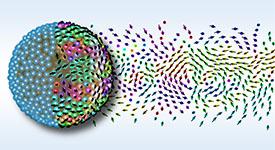

05/31/2021

© 2021 Thomas Russell
An international research team led by Thomas Russell of the AIMR has used hydrodynamics experiments to investigate the magnetization of ferromagnetic liquid droplets1. The results show evidence that the droplet remanent magnetization stems from the magneto-static short-range order between jammed magnetic nanoparticles, opening a new way to tailor the extraordinary material.
Ferromagnetic liquid droplets possess both solid-state magnetic properties and fluid-like shape-morphing capabilities thanks to a unique mechanism: the jamming of paramagnetic nanoparticle surfactants assembled at liquid-liquid interfaces.
This mechanism is believed to lock in the nanoparticles’ short-range magnetic order, generating a remanent magnetization that is impervious to droplet deformation, making the magnetic droplets an ideal candidate for achieving biocompatible liquid robots2.
However, advanced biocompatible capabilities such as targeted drug delivery or functional microfluidic channels entail the controlled shape change at exquisite scales—a feature that requires profound knowledge of how the magnetic handle works; how they evolve with droplet architectures and environments; and how they can be tailored to adapt to these changes. To date, the short-range-order origin of the droplet magnetization remains an unproven theory.
“Short-range magnetic orders are difficult to measure directly,” says Xuefei Wu from Beijing University of Chemical Technology. “They require magnetic imaging or scattering experiments that only provide local information.”
Instead, the team has opted for a global approach, using hydrodynamics experiments to explore the magnetic short-range order. Studying the rotational and translational motions induced to spherical droplets by external magnetic fields enabled the team to express the droplets’ mechanical responses in terms of measurable variables. Thus, the droplets’ angular accelerations and velocities become means of measuring how much magnetic torque they experience.
“The external magnetic fields exert a magnetic torque on the droplet remanent magnetization that are locked in by structural short-range order, and direct the droplets’ motion,” says Robert Streubel of the University of Nebraska-Lincoln. “Choosing spherical paramagnetic nanoparticles also enables the desired reversible transformation between paramagnetic and ferromagnetic liquids.”
With this approach, the team has provided some intriguing evidence for magnetic short-range order: the pH of the droplets’ aqueous phase determines the surfactants’ ability to jam nanoparticles, and controls the amount of torque applied to the droplets; jammed nanoparticles enhance magnetization by coupling with dispersed nanoparticles via magneto-static interactions; the same coupling enables the interfacial assembly to accommodate a surprising amount of non-magnetic nanoparticles while retaining substantial magnetization.
“The surprising thing about the remanent magnetization is that it emerges with the formation of the ferromagnetic liquid droplets,” says Russell. “This is the reason why droplet magnetization only requires low concentrations of magnetic nanoparticles and is preserved through droplet deformation.”
A future direction will combine numerical modeling with hydrodynamics experiments to determine how the nanopatterning of the interfacial layer can further control the droplet magnetization and functionalization.
(Author: Patrick Han)
This research highlight has been approved by the authors of the original article and all information and data contained within has been provided by said authors.